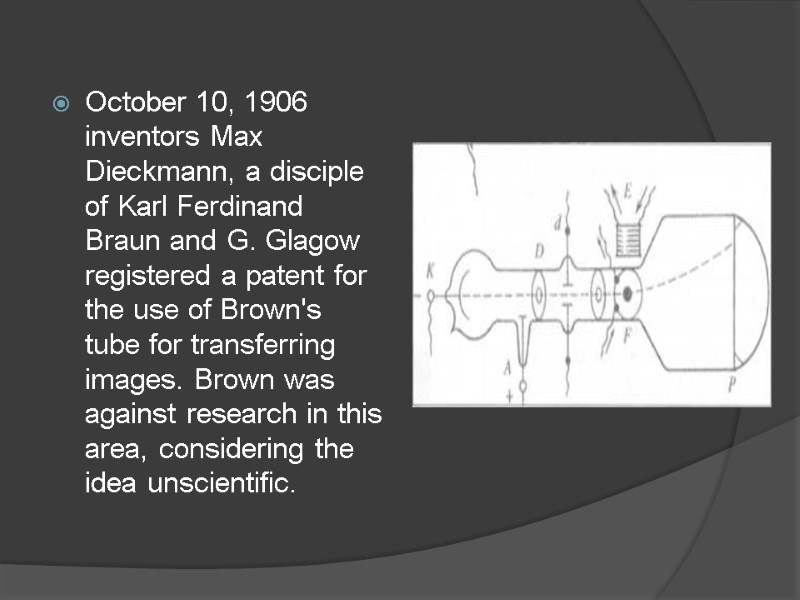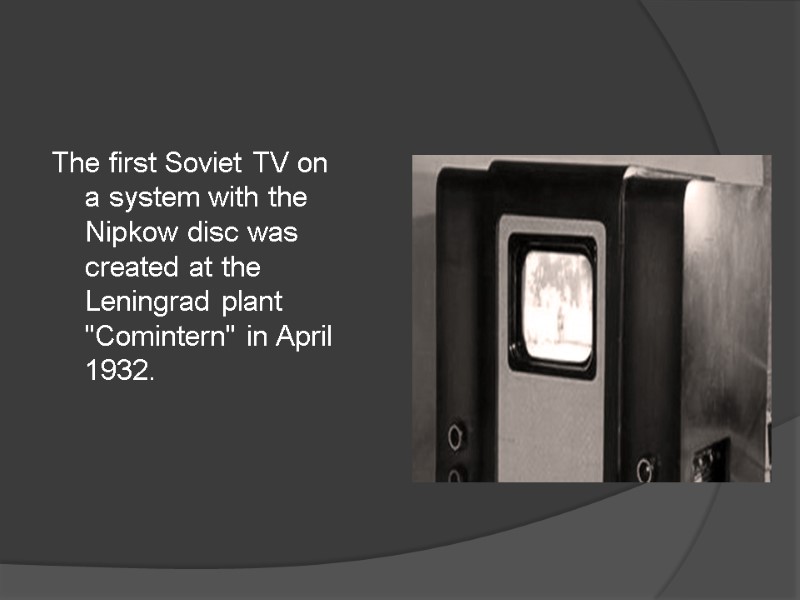TELEVISION. Panchenko Ksenia 10 «B». Television — an


TELEVISION. Panchenko Ksenia 10 «B».

Television - an electronic device for receiving and displaying the image and sound transmitted wirelessly or via cable.

First televisions were mechanical scanning. Then came the black-and-white e-scan cathode-ray tube as a source image. They were very small. Initially TVs were based on vacuum tubes, then there was a shift to the transistors. In the 1980s there was a gradual transition to an integral element base.

The history of creation. The idea of transferring images from a distance has existed since ancient times, finding the mapping in the myths and legends, but the technical and theoretical basis for the creation of such a device appeared only at the end of the XIX century, after the establishment of the radio.

In 1884, German inventor Paul Nipkow invented the Nipkow disk - a device that formed the basis of mechanical television.

October 10, 1906 inventors Max Dieckmann, a disciple of Karl Ferdinand Braun and G. Glagow registered a patent for the use of Brown's tube for transferring images. Brown was against research in this area, considering the idea unscientific.

In 1907, Dickman was shown a television receiver with a screen size of 3x3 cm and a frequency sweep 10 frame / s.

The real breakthrough in technology has made electronic television K. Zworykin - in 1923 he applied for a television based entirely on electronic principle, and in 1931 created the world's first electronic transmission photocathode tube with mosaic called «iconoscope», initiating the development of electronic television.

Iconoscope - the first electronic transmitting television tube, allowed to start mass production of television receivers.

The first Soviet TV on a system with the Nipkow disc was created at the Leningrad plant "Comintern" in April 1932.

In the 70 - 80 years there was a gradual replacement of the park in black and white television to color domestic production. Park was formed color televisions difficult, although their long time even selling below cost. In the early years there was even color broadcasting real sales crisis: population almost ceased to fly the black and white TV on the occasion of "the advent of color television," but still quite hesitant to buy expensive color without being sure of their quality and reliability.

Until about the 1990s TV used solely on the basis of the kinescope. At the end of XX century began to be spread projection TVs. There are TVs from almost flat and then completely flat, kinescopes, had dark picture tubes with improved transmission black picture tubes with a short tube.

At the beginning of XXI century were mass produced TVs with LCD and plasma screens, due to the rapid reduction in price steadily replacing traditional CRT . Screen size modern domestic television can reach up to several meters. TVs with a very large aspect ratio and can be made on the basis of the matrix of discrete LEDs , or based on the matrix of plasma panels. October 28, 2008 went on sale the first model of a commercial laser TV.
13200-television.ppt
- Количество слайдов: 13

